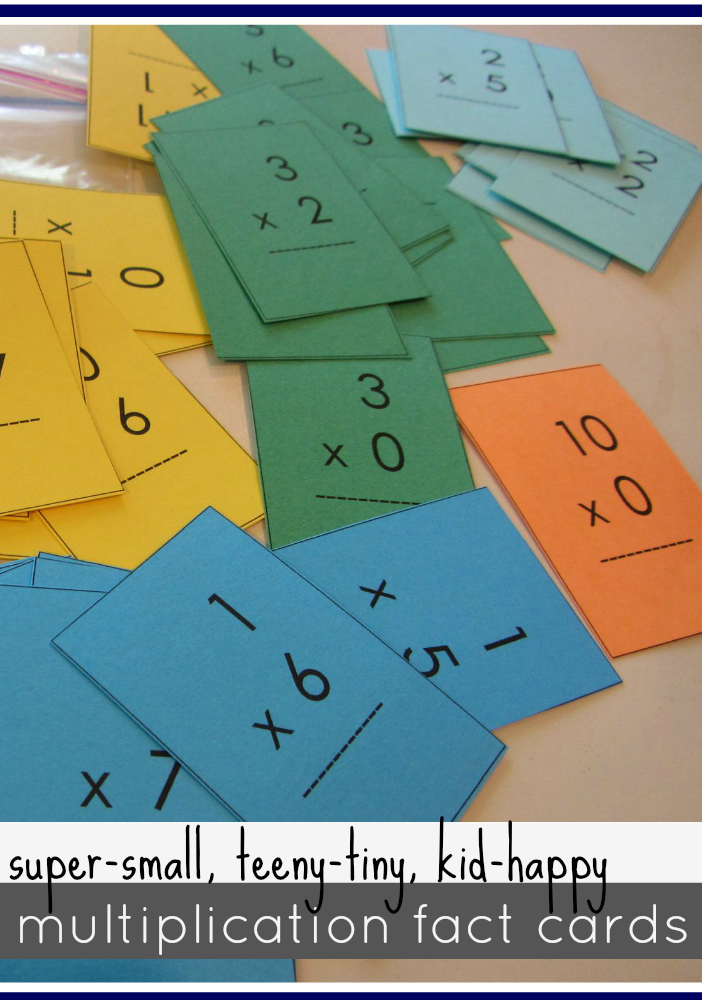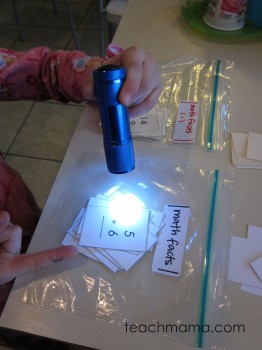Learning math facts has been a long, hard road for Maddy.
It’s actually very often a long, hard road for many kids–including myself–way back when.
I remember hours of practicing my basic facts and hours of frustration at the fact that I just wasn’t learning. I just wasn’t remembering. I felt anxiety on every Mad Minute; I felt stupid because other kids were able to do so much more than I. I felt angry. And confused.
Eventually I got over it, but to this day, I still feel like I don’t really know math like I should. So I’ve been determined to support my children’s learning of math from the very beginning.
We’ve tried to make math an everyday thing for us; we try to incorporate it into our morning newspaper reading to our trips in the car to preschool–or anywhere. We use flashcards often and openly.
And for a long time I felt a wee bit guilty about the fact that we’ve been creating–and using–math fact flash cards for weeks and months and years. I’m not sure why I felt bad, but I did.
If I were a halfway decent mom, I’d help her learn these facts in fun and creative ways all of the time, I convinced myself.
I tried to make flash card practices fun, exciting, and sneaky, but what I realized before long is that it’s hard–really hard–to make flash card work fun all of the time. I get that. But what I have been reading, researching, and remembering is that flashcards aren’t all that bad. (Woo-hoo!)
Here’s the skinny. . .
- Mastering Multiplication Tables: We have flash cards with us usually at all times. I simply throw a set into my bag or in the car, in the event that we are stuck somewhere and have time that we can bust out a little addition or subtraction fun.

multiplication table mini flash cards
Only recently has Maddy been invited to move forward and into multiplication in her weekly math-fact assessments, and we realized that a lot of the multiplication learning fell on our shoulders since technically, multiplication is a third grade component.
First of all, I made math fact cards multiplication, following the format of our addition and subtraction mini flash cards.
The math fact cards multiplication can be printed as a pdf on cardstock, cut, and either used together or by number families. Then throw ’em in a bag, and you’re ready to roll.
Then we started using them. I pulled them out here, there, and everywhere:
- in the car, waiting to pick up kids or drop them off;
- while preparing dinner;
- before or after bedtime books;
- at the grocery store;
- out front, out back, outdoors, or in;
- while drying hair;
- before or after homework;
- anywhere and everywhere.
Some days, we’d just run through them one by one. Other days, we’d mix it up. We might:
- play ‘Shine On’ — flip the top card on two piles and shine a flashlight on the first answer she knows;
- race — Maddy and I race to say the answer to the card that’s flipped;
- use chalk, paint, markers, water–anything–to write the answer to the flipped card;
- play ‘High/Low’ — flip the top card on two piles and point to the card that shows the higher (or lower) number as the answer;
- just plain-Jane call out the answers.
Whatever floats our boat, whichever way the wind carries us that day.
And recently I ran across an article on Mom’s Homeroom about learning the times tables (“Make Time for the Times Tables,” by Laura Liang, and I was literally doing a jig of joy because the teacher-expert who wrote it actually advocated for using flashcards to learn the (sometimes) tricky multiplication tables. Actually, she didn’t say that outright; she said that “relying on one strategy is not enough” and that “memorization and the ability to model the facts are both necessary.” Yay! Yes! Woot!
I knew this–of course I did! It’s the same deal with teaching reading–and nearly everything else. We don’t rely on one type of strategy to teach reading comprehension; rather, it’s a combination of strategies and techniques, a combination catered especially to each learner’s needs.
So from here on out, I’m going to continue flashing those multiplication cards to my Maddy, helping her to memorize–but also to learn the number concepts of those tricky multiplication tables. And hopefully other parents will do the same. Happy flash-carding and math-learning!
fyi: This blog post is part of an incentivized online influencer network for Mom’s Homeroom. Mom’s Homeroom is brought to you by Frosted Mini-Wheats.


My 4th grade still struggles with some of her multiplication facts! Hope to come up with fun ideas this summer, plus I need to remember to bring the flash cards everywhere. Awesome idea!
Jen
good to know, Jen! I plan to upload the file but was having a hard time w/ internet today…will def share soon! thanks for reading, friend!!
Oh, I am so, so happy to know I am not the only mom going through this…my daughter is in fourth grade and still has yet to memorize her multiplication facts! I have used every “strategy” there is but always go back to flash cards! Thank you for some fun ways to use them and thank you for sharing this!!!!
Stacy– Thank YOU for letting me know I’m not alone (and Maddy’s not alone, either!). Cannot thank you enough for reading, and huge thanks for taking the time to write, my friend!! Good luck–and let’s stay in touch!
So funny… I just created a new multiplication fact game this weekend for Caroline. Tricky facts all around I guess!
Stacey!! Seriously?! can you please share? How about a guest post? . . . Thanks for reading, my friend–and YES! they’re tricky!!
Hi Amy! You are doing great!!! As long as you’re giving them love along with learning, you are fine!!! 🙂
Some of my ideas off top of head:
Add on to flashcards: I noticed you have just numerals on flashcards. You can also put visual (dots or whatever) to help? For ex: “3 x 4 = ?” have a rectangle of 3 dots by 4 dots. Yes eventually the child should have to “count it out” so you can go from visual cards with numerals to just the numerals. BUT in the end, she’ll have that picture in her head to help. (I am a big visual learner myself so tend to teach that way!)
ALSO, I remember my dad making a BIG poster of all the times table that we hung in kitchen to review when we ate. He had us SING the multiplication table and tape recorded us so that we could listen to it as we fell alseep. 🙂
Trying to help with different types of learners. Not sure how your kids are.
GOOD LUCK! If you ever get an extra moment in Bethlehem (I know I know), tell Mary to contact me for help. 🙂
take care, trisha
TRISHA!!! Thank you so much for the support and kind words!! I will DEFINITELY try your suggestions–I love the poster idea especially, and I will try to find the song somewhere if I can. . . love it! Or maybe teach it to Mary so she can teach it to us??! I would love to eventually meet up in Bhem–perhaps this summer once school’s out and life settles a bit?! Thanks again– you. are. awesome!!
Great idea Amy! my son is in second grade and he is starting to learn to multiply. Last week I printed a multiplication chart and he is trying to memorize but if I want to come up with something better and not too boring. I’m going to try your mini flashcards. Do you mix them all? or you do in it in order from 1 to 12? Thanks!
growingbilingual.com,
Silke!! I need to get a multiplication chart as well–great idea! I started them in order from 1-12, and after she ‘covers’ a family, we mix them up into ‘mixed’ bags. It’s been working out well. Thanks for reading, and huge thanks for writing, my friend!
Amy,
Thanks for the inspiration! My daughter is almost done K and doing addition and subtraction facts everyday in school. Like you, I tend to focus more on literacy at home which I heart! Time to break out your addition minis to get a better balance. We have tried games, she gets the concepts, but has not memorized the facts yet. What are your thoughts about memorization for K?
Kelly–thanks for reading, my friend! If you’re talking about memorization of some of the basic sight words, then I’m for it, but not much other than that, I’d say. Just those words that they cannot sound out or don’t follow phonological ‘rules’. . . What do you think?
All for the sight words, and we had fun learning them! Just wondering about what age you think for addition minis? I know every kiddo is so different and this is probably a hard question. Thanks for all of your ideas. I tell so many parents and teacher from my daughter’s school about your blog and we teach. Such great resources!! Keep up the great work.
Meant teachers 🙂
Hi, Kelly! Thank you SO much for your kind words and promotion of the sites. Can’t tell you how much I appreciate it!! I’d say that the addition mini’s can start once children are learning them in school–I think Maddy started them in grade one. 🙂
I enjoy your website. I came across your web site by way of toddler planet and I’m so glad I bookmarked it!As a fellow mom looking for new ways all the time to make learning fun, I enjoy your ideas. I’m lucky with my oldest, she loves math and has been craving ways to learn multiplication so this just hits the spot. I also have a future kindergartner in my home so those addition flash cards will come in handy!
THanks!
ooooh, I cannot tell you how much it means to know that you found me via my sweet friend Susan. I miss her every day. Thank you so very much for reading and for taking the time to send me this feedback; it means so much and so very glad the activities are helpful for your children! Stay in touch!
I’d like to also suggest a website called xtramath.com. My 6 and 7 year olds use it and it has been so helpful. There’s not a lot of bells and whistles, just math drills. But what I love most is how it sends progress reports each week and I can check to see which facts the kids are missing and drill them on those more. My first grader has gone through addition and subtraction and just started multilication today. My kindergertener started addition two months ago and is at about 80%. You should definitely check it out. Best part – it’s free.
ROBYN! Thank you thank you thank you. LOVE it. Just showed it to my kiddos yesterday, and one in particular has fallen head over heels. It’s really an awesome site. Cannot thank you enough for reading–and taking the time to write, my friend. yay!!!!
I just came across these wonderful flash cards and plan to use them all! Thank you so much for sharing! I searched for division flash cards on your site and didn’t find any. Any chance you made those at well?
Hi, Sarah! I don’t think I made division cards. . . but I should!
Have you heard about Jo Boaler…. the stanford professor who’s an expert in this field.
https://news.stanford.edu/2015/01/29/math-learning-boaler-012915/